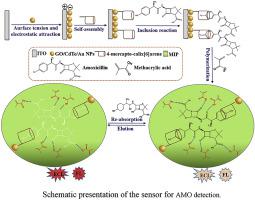当前位置:
X-MOL 学术
›
Anal. Chim. Acta
›
论文详情
Our official English website, www.x-mol.net, welcomes your
feedback! (Note: you will need to create a separate account there.)
Novel molecularly imprinted amoxicillin sensor based on a dual recognition and dual detection strategy
Analytica Chimica Acta ( IF 5.7 ) Pub Date : 2020-08-01 , DOI: 10.1016/j.aca.2020.06.034 Shuhuai Li 1 , Xionghui Ma 1 , Chaohai Pang 1 , Haibo Li 1 , Chunhua Liu 1 , Zhi Xu 1 , Jinhui Luo 1 , Yan Yang 2
Analytica Chimica Acta ( IF 5.7 ) Pub Date : 2020-08-01 , DOI: 10.1016/j.aca.2020.06.034 Shuhuai Li 1 , Xionghui Ma 1 , Chaohai Pang 1 , Haibo Li 1 , Chunhua Liu 1 , Zhi Xu 1 , Jinhui Luo 1 , Yan Yang 2
Affiliation

|
The use of dual recognition and multiple detection modes is an attractive strategy for realising sensors with improved selectivity and accuracy. Herein, a molecularly imprinted polymer (MIP)-based sensor is developed for amoxicillin detection based on two detection modes (fluorescence and electrochemiluminescence) and dual recognition. First, graphene oxide loaded with CdTe quantum dots/gold nanoparticles (GO/CdTe/Au NPs) is coated onto an indium tin oxide (ITO) electrode. Then, 4-mercapto-calix[6]arene is bonded to GO/CdTe/Au NPs as the first recognition element, which then form a host-guest complex with the target molecule amoxicillin. Subsequently, as the second recognition element, an MIP is prepared on the ITO electrode. After amoxicillin is removed from the MIP, specific identification sites for amoxicillin are obtained. Furthermore, the GO/CdTe/Au NPs can generate fluorescence and electrochemiluminescence signals that are effectively quenched by amoxicillin. Therefore, on/off switching of these signals can be achieved through the elution or adsorption of amoxicillin. The dual detection modes are complementary and provide mutual authentication, which can improve the detection accuracy and application scope. Moreover, the dual recognition sites for amoxicillin, improve detection selectivity. The fluorescence and electrochemiluminescence modes have detection ranges of 5-1000 × 10-11 mol L-1 and 5-1500 × 10-11 mol L-1, respectively, with detection limits of 9.2 × 10-12 mol L-1 and 8.3 × 10-12 mol L-1, respectively.
中文翻译:

基于双识别双检测策略的新型分子印迹阿莫西林传感器
双重识别和多种检测模式的使用是实现具有更高选择性和准确性的传感器的有吸引力的策略。在此,基于分子印迹聚合物(MIP)的传感器被开发用于基于两种检测模式(荧光和电化学发光)和双重识别的阿莫西林检测。首先,将负载有 CdTe 量子点/金纳米粒子 (GO/CdTe/Au NPs) 的氧化石墨烯涂覆在氧化铟锡 (ITO) 电极上。然后,4-巯基-杯[6]芳烃作为第一个识别元件与GO/CdTe/Au NPs结合,然后与目标分子阿莫西林形成主客体复合物。随后,作为第二识别元件,在ITO电极上制备MIP。从 MIP 中去除阿莫西林后,可以获得阿莫西林的特定识别位点。此外,GO/CdTe/Au NPs 可以产生被阿莫西林有效淬灭的荧光和电化学发光信号。因此,这些信号的开/关切换可以通过阿莫西林的洗脱或吸附来实现。两种检测方式相辅相成,相互认证,可以提高检测精度和应用范围。此外,阿莫西林的双重识别位点提高了检测选择性。荧光和电化学发光模式的检测范围分别为5-1000 × 10-11 mol L-1和5-1500 × 10-11 mol L-1,检测限分别为9.2 × 10-12 mol L-1和8.3 × 10-12 mol L-1,分别。这些信号的开/关切换可以通过阿莫西林的洗脱或吸附来实现。两种检测方式相辅相成,相互认证,可以提高检测精度和应用范围。此外,阿莫西林的双重识别位点提高了检测选择性。荧光和电化学发光模式的检测范围分别为5-1000 × 10-11 mol L-1和5-1500 × 10-11 mol L-1,检测限分别为9.2 × 10-12 mol L-1和8.3 × 10-12 mol L-1,分别。这些信号的开/关切换可以通过阿莫西林的洗脱或吸附来实现。两种检测方式相辅相成,相互认证,可以提高检测精度和应用范围。此外,阿莫西林的双重识别位点提高了检测选择性。荧光和电化学发光模式的检测范围分别为5-1000 × 10-11 mol L-1和5-1500 × 10-11 mol L-1,检测限分别为9.2 × 10-12 mol L-1和8.3 × 10-12 mol L-1,分别。
更新日期:2020-08-01
中文翻译:

基于双识别双检测策略的新型分子印迹阿莫西林传感器
双重识别和多种检测模式的使用是实现具有更高选择性和准确性的传感器的有吸引力的策略。在此,基于分子印迹聚合物(MIP)的传感器被开发用于基于两种检测模式(荧光和电化学发光)和双重识别的阿莫西林检测。首先,将负载有 CdTe 量子点/金纳米粒子 (GO/CdTe/Au NPs) 的氧化石墨烯涂覆在氧化铟锡 (ITO) 电极上。然后,4-巯基-杯[6]芳烃作为第一个识别元件与GO/CdTe/Au NPs结合,然后与目标分子阿莫西林形成主客体复合物。随后,作为第二识别元件,在ITO电极上制备MIP。从 MIP 中去除阿莫西林后,可以获得阿莫西林的特定识别位点。此外,GO/CdTe/Au NPs 可以产生被阿莫西林有效淬灭的荧光和电化学发光信号。因此,这些信号的开/关切换可以通过阿莫西林的洗脱或吸附来实现。两种检测方式相辅相成,相互认证,可以提高检测精度和应用范围。此外,阿莫西林的双重识别位点提高了检测选择性。荧光和电化学发光模式的检测范围分别为5-1000 × 10-11 mol L-1和5-1500 × 10-11 mol L-1,检测限分别为9.2 × 10-12 mol L-1和8.3 × 10-12 mol L-1,分别。这些信号的开/关切换可以通过阿莫西林的洗脱或吸附来实现。两种检测方式相辅相成,相互认证,可以提高检测精度和应用范围。此外,阿莫西林的双重识别位点提高了检测选择性。荧光和电化学发光模式的检测范围分别为5-1000 × 10-11 mol L-1和5-1500 × 10-11 mol L-1,检测限分别为9.2 × 10-12 mol L-1和8.3 × 10-12 mol L-1,分别。这些信号的开/关切换可以通过阿莫西林的洗脱或吸附来实现。两种检测方式相辅相成,相互认证,可以提高检测精度和应用范围。此外,阿莫西林的双重识别位点提高了检测选择性。荧光和电化学发光模式的检测范围分别为5-1000 × 10-11 mol L-1和5-1500 × 10-11 mol L-1,检测限分别为9.2 × 10-12 mol L-1和8.3 × 10-12 mol L-1,分别。











































 京公网安备 11010802027423号
京公网安备 11010802027423号